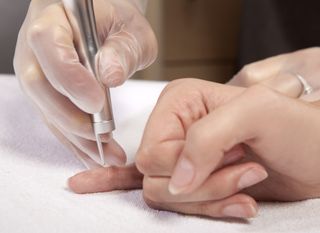What's the Best Way to Treat Warts?

"The Healthy Geezer" answers questions about health and aging in his weekly column.
Question: Can you get rid of warts with duct tape?
Answer: For starters, check with your doctor before beginning any self-treatment for warts. You might mistake another kind of skin growth for a wart and hurt yourself.
The jury is still out on duct-tape therapy for warts. A recent study showed that duct tape wiped out more warts than conventional freezing did. In this study, warts were covered with duct tape for six days. Then, the warts were soaked in warm water and rubbed with an abrasive such as pumice stone. The treatment was repeated for as long as two months.
However, subsequent research has not found duct tape to be significantly effective for treating warts.
You can treat warts at home with medications from the drugstore. Get a patch or solution that contains 17 percent salicylic acid. You have to use these products daily for weeks.
Two of these medications are Compound W and Occlusal-HP. Dr. Scholl makes a different product called Freeze Away that it claims that it removes warts "with as few as one treatment."
Sign up for the Live Science daily newsletter now
Get the world’s most fascinating discoveries delivered straight to your inbox.
Warts are benign skin growths caused by human papillomavirus (HPV). Like other infectious diseases, wart viruses pass from person to person. You can also get the wart virus by touching an object used by someone who has the virus.
Warts are usually rough and skin-colored. However, they can be dark, flat and smooth.
Warts may grow one at a time or in bunches. They may bleed if picked or cut. They often contain one or more tiny black dots, which are sometimes called wart seeds. These dots are small, clotted blood vessels.
There are several kinds of warts.
Common warts grow on hands. They are more common where skin has been broken, such as where fingernails are bitten.
Plantar warts are found on the soles, or plantar area, of feet. Walking pushes plantar warts back into the skin. They can be painful. When they grow in clusters, they are known as mosaic warts.
Flat warts are small, smooth and tend to grow in large numbers. They can show up anywhere on the body. They are often found where people shave—the face on men and the legs on women. Irritation from shaving probably contributes to the development of flat warts.
Genital warts are sexually transmitted. They can appear externally or internally.
The wart virus affects people differently. Some people get warts; others don't. The likelihood of getting warts is similar to the chances of catching a cold. If your immune system is weak, you will be more prone to getting warts.
Freezing — or cryotherapy — is one method for removing warts. Burning — or electrosurgery — is an alternative. Lasers are used when other therapies fail. There are also surface-peeling preparations such as salicylic acid. Retinoids, which are medications derived from vitamin A, are used to disrupt a wart's skin cell growth.
Another treatment is to inject each wart with an anti-cancer drug called bleomycin. The injections may be painful and can have other side effects. Immunotherapy, which attempts to use the body's own rejection system is an additional treatment method.
New warts should be treated as soon as possible to prevent them from shedding virus into nearby skin and creating additional warts.
If you like to read more columns, you can order a copy of "How to be a Healthy Geezer" at http://www.healthygeezer.com.
All rights reserved © 2011 by Fred Cicetti
More from the Healthy Geezer:
Most Popular


